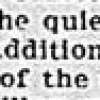Free Online Productivity Tools
i2Speak
i2Symbol
i2OCR
iTex2Img
iWeb2Print
iWeb2Shot
i2Type
iPdf2Split
iPdf2Merge
i2Bopomofo
i2Arabic
i2Style
i2Image
i2PDF
iLatex2Rtf
Sci2ools
CVPR
2010
IEEE
2010
IEEE
Improving State-of-the-Art OCR through High-Precision Document-Specific Modeling
Optical character recognition (OCR) remains a difficult problem for noisy documents or documents not scanned at high resolution. Many current approaches rely on stored font models that are vulnerable to cases in which the document is noisy or is written in a font dissimilar to the stored fonts. We address these problems by learning character models directly from the document itself, rather than using pre-stored font models. This method has had some success in the past, but we are able to achieve substantial improvement in error reduction through a novel method for creating nearly error-free document-specific training data and building character appearance models from this data. In particular, we first use the state-of-the-art OCR system Tesseract to produce an initial translation. Then, our method identifies a subset of words that we have high confidence have been recognized correctly and uses this subset to bootstrap document-specific character models. We present theoretical justific...
| Added | 01 Apr 2010 |
| Updated | 14 May 2010 |
| Type | Conference |
| Year | 2010 |
| Where | CVPR |
| Authors | Andrew Kae, Gary Huang, Erik Learned-miller, Carl Doersch |
Comments (0)

